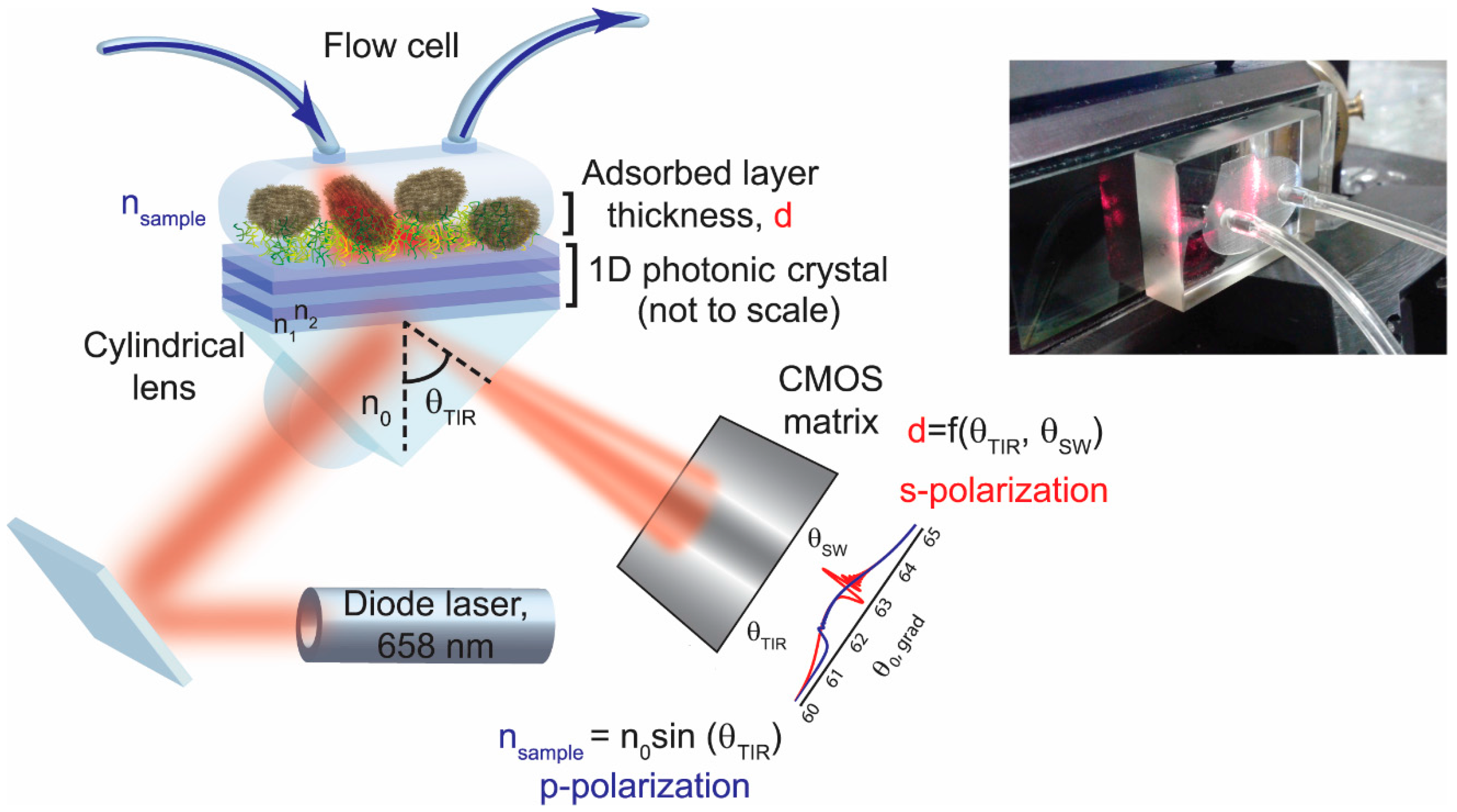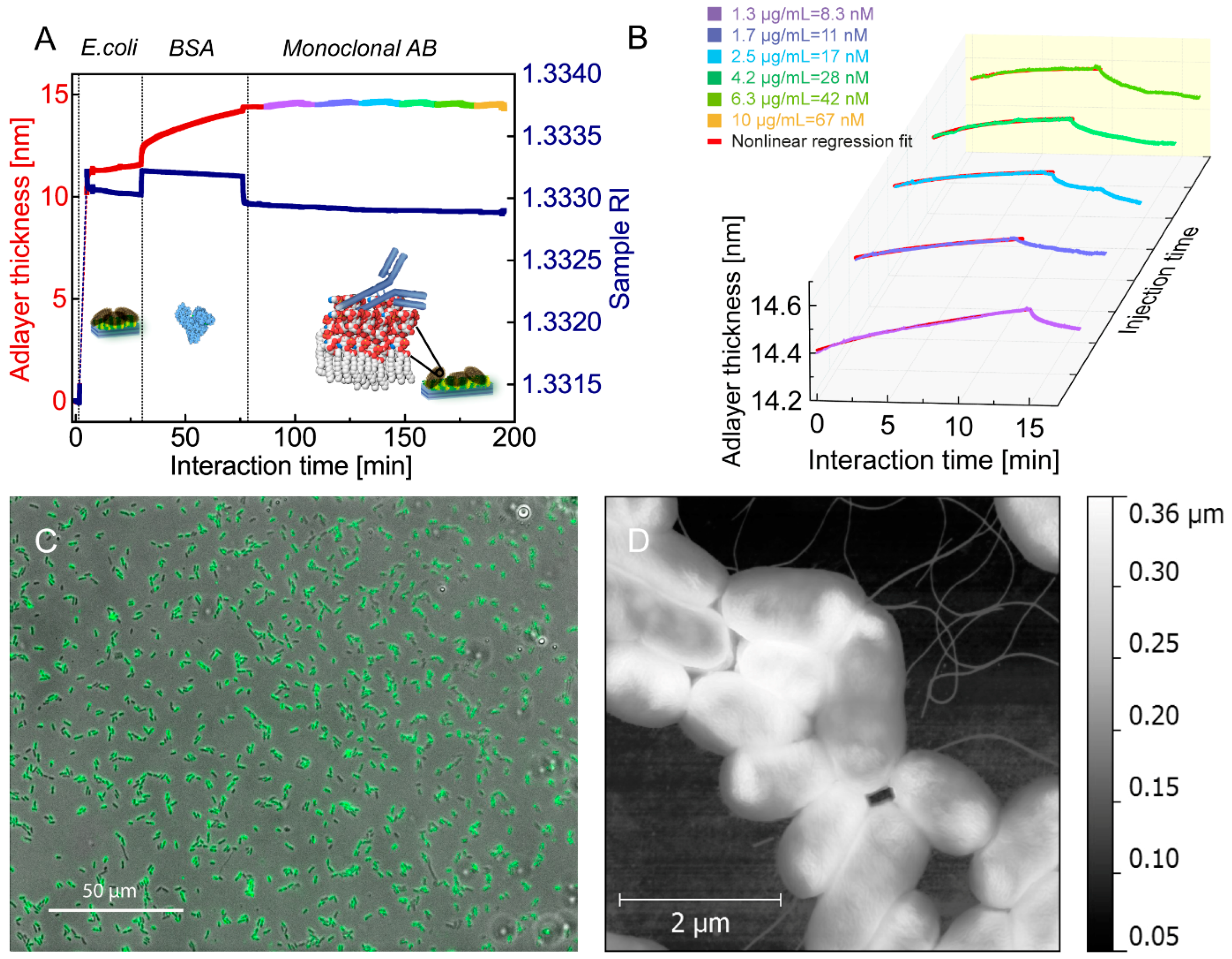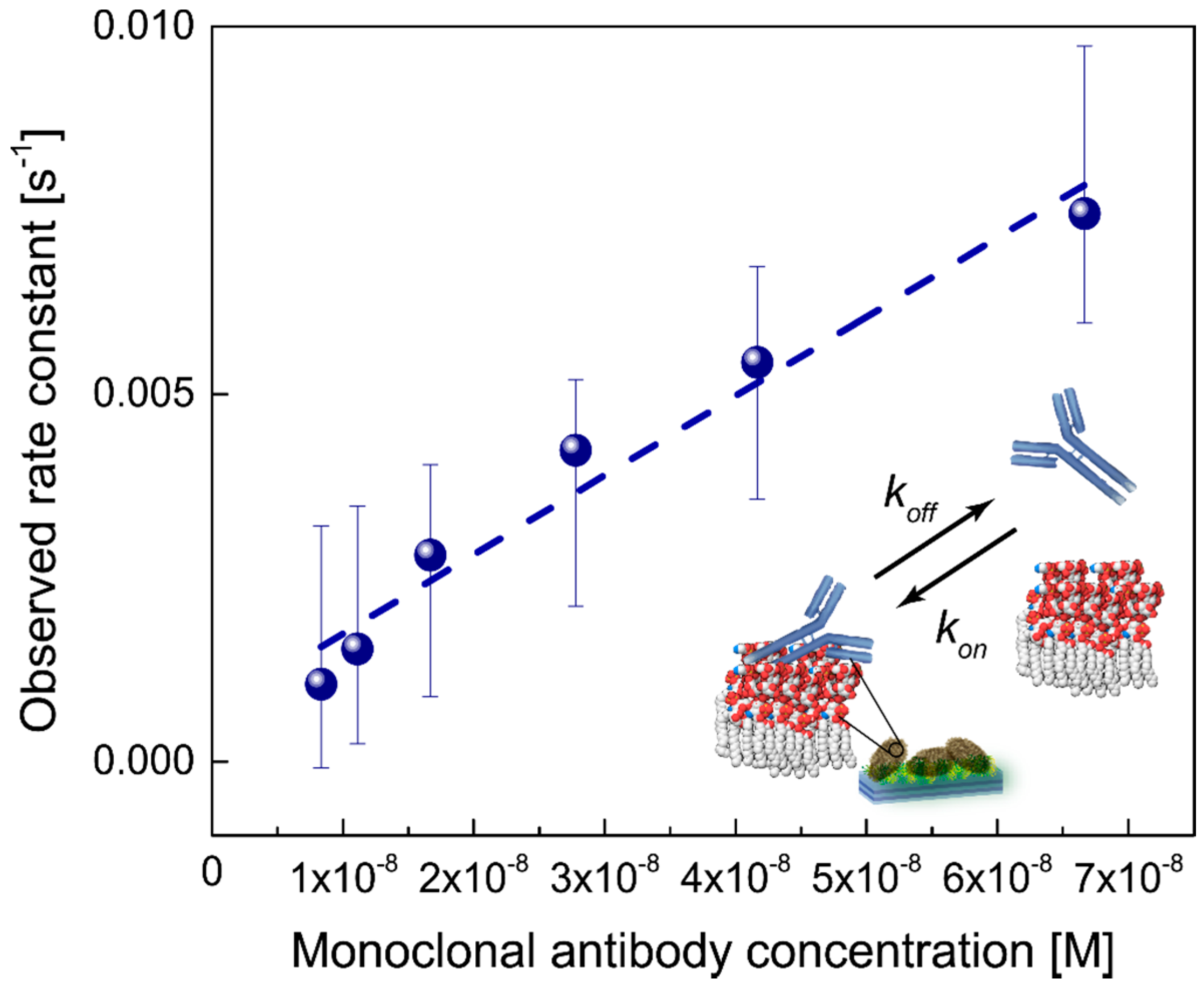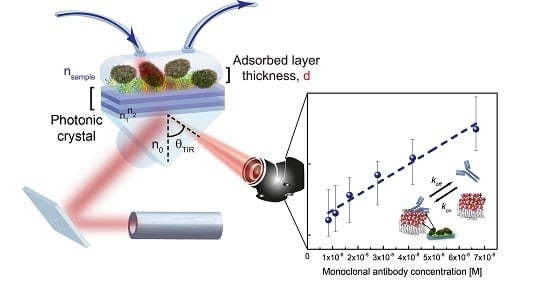Kinetics of Antibody Binding to Membranes of Living Bacteria Measured by a Photonic Crystal-Based Biosensor
Abstract
:1. Introduction
2. Materials and Methods
2.1. Biosensor Setup (Figure 1)
2.2. Experiment Protocol
2.3. Reagents
2.4. Data Handling and Binding Model
3. Results and Discussion
3.1. Binding of Bacteria E. coli DH5α
3.2. Mono- and Polyclonal Antibody Binding
4. Conclusions
Supplementary Materials
Acknowledgments
Author Contributions
Conflicts of Interest
References
- O’Neill, J. Antimicrobial Resistance: Tackling a Crisis for the Health and Wealth of Nations; AMR Review: London, UK, 2014; pp. 1–16. [Google Scholar]
- Gregori-Puigjané, E.; Setola, V.; Hert, J.; Crews, B.A.; Irwin, J.J.; Lounkine, E.; Marnett, L.; Roth, B.L.; Shoichet, B.K. Identifying mechanism-of-action targets for drugs and probes. Proc. Natl. Acad. Sci. USA 2012, 109, 11178–11183. [Google Scholar] [CrossRef] [PubMed]
- Robertson, W.M.; May, M.S. Surface electromagnetic wave excitation on one-dimensional photonic band-gap arrays. Appl. Phys. Lett. 1999, 74, 1800. [Google Scholar] [CrossRef]
- Fan, X.; White, I.M.; Shopova, S.I.; Zhu, H.; Suter, J.D.; Sun, Y. Sensitive optical biosensors for unlabeled targets: A review. Anal. Chim. Acta 2008, 620, 8–26. [Google Scholar] [CrossRef] [PubMed]
- Medina, M.B.; van Houten, L.; Cooke, P.H.; Tu, S.I. Real-time analysis of antibody binding interactions with immobilized E. coli O157:H7 cells using the BIAcore. Biotechnol. Tech. 1997, 11, 173–176. [Google Scholar]
- Krupin, O.; Wang, C.; Berini, P. Selective capture of human red blood cells based on blood group using long-range surface plasmon waveguides. Biosens. Bioelectron. 2014, 53, 117–122. [Google Scholar] [CrossRef] [PubMed]
- Konopsky, V.N.; Alieva, E.V. Photonic crystal surface waves for optical biosensors. Anal. Chem. 2007, 79, 4729–4735. [Google Scholar] [CrossRef] [PubMed]
- Konopsky, V.N.; Karakouz, T.; Alieva, E.V.; Vicario, C.; Sekatskii, S.K.; Dietler, G. Photonic crystal biosensor based on optical surface waves. Sensors 2013, 13, 2566–2578. [Google Scholar] [CrossRef] [PubMed]
- Song, Q.W.; Ku, C.-Y.; Zhang, C.; Michalak, R. Modified critical angle method for measuring the refractive index of bio-optical materials and its application to bacteriorhodopsin. J. Opt. Soc. Am. B 1995, 12, 797. [Google Scholar] [CrossRef]
- Liu, P.Y.; Chin, L.K.; Ser, W.; Ayi, T.C.; Yap, P.H.; Bourouina, T.; Leprince-Wang, Y. An optofluidic imaging system to measure the biophysical signature of single waterborne bacteria. Lab Chip 2014, 14, 4237–4243. [Google Scholar] [CrossRef] [PubMed]
- Konopsky, V.N.; Alieva, E.V. A biosensor based on photonic crystal surface waves with an independent registration of the liquid refractive index. Biosens. Bioelectron. 2010, 25, 1212–1216. [Google Scholar] [CrossRef] [PubMed]
- Konopsky, V.N. Plasmon-polariton waves in nanofilms on one-dimensional photonic crystal surfaces. New J. Phys. 2010, 12, 093006. [Google Scholar] [CrossRef]
- Kim, J.K.; Shin, D.S.; Chung, W.J.; Jang, K.H.; Lee, K.N.; Kim, Y.K.; Lee, Y.S. Effects of polymer grafting on a glass surface for protein chip applications. Colloids Surf. B Biointerfaces 2004, 33, 67–75. [Google Scholar] [CrossRef]
- Huang, C.J.; Knoll, W.; Sessitsch, A.; Dostalek, J. SPR bacterial pathogen biosensor: The importance of fluidic conditions and probing depth. Talanta 2014, 122, 166–171. [Google Scholar] [CrossRef] [PubMed]
- Simfit: Simulation, Statistical Analysis, Curve Fitting and Graph Plotting. Available online: http://www.simfit.org.uk/ (accessed on 3 October 2016).
- Motulsky, H.; Christopoulos, A. Fitting Models to Biological Data Using Linear and Nonlinear Regression; Oxford University Press: Oxford, UK, 2004. [Google Scholar]
- Hadi, A.S.; Samprit, C. Regression Analysis by Example, 4th ed.; Wiley-Interscience: Hoboken, NJ, USA, 2006; Volume 1. [Google Scholar]
- Tamm, L.; Bartoldus, I. Antibody binding to lipid model membranes. The large-ligand effect. Biochemistry 1988, 27, 7453–7458. [Google Scholar]
- Syal, K.; Wang, W.; Shan, X.; Wang, S.; Chen, H.Y.; Tao, N. Plasmonic imaging of protein interactions with single bacterial cells. Biosens. Bioelectron. 2015, 63, 131–137. [Google Scholar] [CrossRef] [PubMed]
- Sem, D.S.; McNeeley, P.A.; Linnik, M.D. Antibody affinities and relative titers in polyclonal populations: Surface plasmon resonance analysis of anti-DNA antibodies. Arch. Biochem. Biophys. 1999, 372, 62–68. [Google Scholar] [CrossRef] [PubMed]
- Müller-Loennies, S.; Brade, L.; MacKenzie, C.R.; di Padova, F.E.; Brade, H. Identification of a cross-reactive epitope widely present in lipopolysaccharide from enterobacteria and recognized by the cross-protective monoclonal antibody WN1 222-5. J. Biol. Chem. 2003, 278, 25618–25627. [Google Scholar] [CrossRef] [PubMed]



© 2016 by the authors; licensee MDPI, Basel, Switzerland. This article is an open access article distributed under the terms and conditions of the Creative Commons Attribution (CC-BY) license (http://creativecommons.org/licenses/by/4.0/).
Share and Cite
Rostova, E.; Ben Adiba, C.; Dietler, G.; Sekatskii, S.K. Kinetics of Antibody Binding to Membranes of Living Bacteria Measured by a Photonic Crystal-Based Biosensor. Biosensors 2016, 6, 52. https://doi.org/10.3390/bios6040052
Rostova E, Ben Adiba C, Dietler G, Sekatskii SK. Kinetics of Antibody Binding to Membranes of Living Bacteria Measured by a Photonic Crystal-Based Biosensor. Biosensors. 2016; 6(4):52. https://doi.org/10.3390/bios6040052
Chicago/Turabian StyleRostova, Ekaterina, Carine Ben Adiba, Giovanni Dietler, and Sergey K. Sekatskii. 2016. "Kinetics of Antibody Binding to Membranes of Living Bacteria Measured by a Photonic Crystal-Based Biosensor" Biosensors 6, no. 4: 52. https://doi.org/10.3390/bios6040052
APA StyleRostova, E., Ben Adiba, C., Dietler, G., & Sekatskii, S. K. (2016). Kinetics of Antibody Binding to Membranes of Living Bacteria Measured by a Photonic Crystal-Based Biosensor. Biosensors, 6(4), 52. https://doi.org/10.3390/bios6040052





